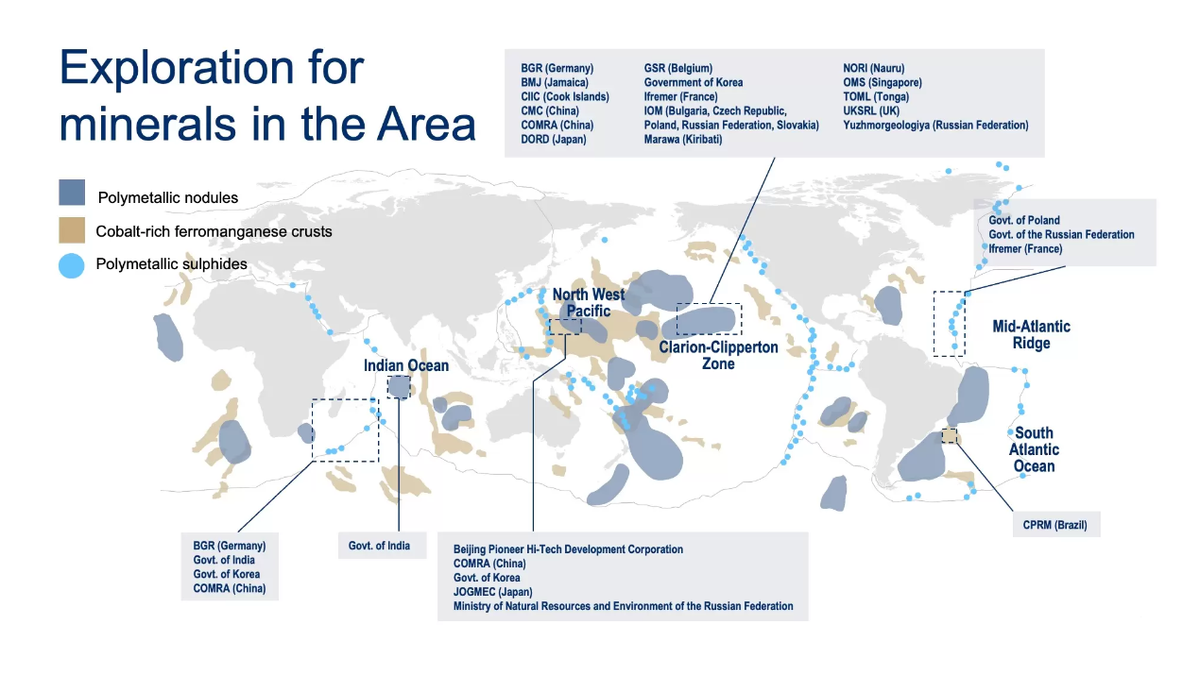Context
-
The two-year deadline for the International Seabed Authority (ISA) to finalise deep-sea mining rules, set in 2021, has ended.
What is deep-sea mining?
- According to the International Union for Conservation of Nature (IUCN), the extraction of mineral resources from the ocean below 200 metres is called deep sea mining.
- Seabed ecosystems are not yet fully explored, and depleting terrestrial deposits amid an increasing demand for metals like lithium, cobalt, copper, nickel, and manganese has driven increased demand to explore deep sea mining.
What are the proposed methods to conduct deep sea mining?
According to Deep Sea Conservation Coalition (DSSC), an initiative formed in 2004 to safeguard deep-sea ecosystems, the seabed can be mined in three ways:
- Extracting metals from polymetallic nodules on abyssal plains: Abyssal plains are underwater plains on the sea floor. Polymetallic nodules contain a variety of metals including manganese, iron, copper, nickel, cobalt, lead and zinc, and small but significant concentrations of molybdenum, lithium, titanium, and niobium, among others.
- Stripping cobalt crusts from seamounts: Scientists believe that underwater mountains formed through volcanic activity are potentially rich in cobalt. Cobalt crusts accumulate at depths of between 400 and 7,000 metres. Seamounts are also rich sources of iron, manganese, nickel, copper and various rare metals, including rare earth elements.
- Extracting polymetallic sulphides from hydrothermal vents: These are also called sea floor massive sulphides and are rich in copper, iron, zinc, silver and gold. Active hydrothermal vents are also homes to unique ecosystems, containing chemosynthetic bacteria, giant tube worms, crustaceans, molluscs and other species— many believed to be endemic to the vents.
What is the ongoing issue around deep-sea mining?
- In June 2021, the government of Nauru, a small Micronesian island off the coast of Australia, notified the ISA that they intended to begin deep sea mining and that the organisation should formulate its rules about the same in two years.
- Important metals like cobalt, copper, nickel, and manganese, used extensively in batteries, are believed to be abundant in the Clarion-Clipperton Zone (CCZ) in the North Pacific Ocean between Hawaii and Mexico.
- So far, ISA has only issued exploration contracts (31 till May 2022), but IUCN believes that deep sea mining in international waters could start by 2026.

What are the concerns around deep sea mining?
- Right off the bat, humans have very limited knowledge of the seabed.
- The deep sea is one of the most inaccessible parts of the earth. According to DSSC, exploitation can cause irreversible damage to the fragile deep-sea ecosystem.
- deep-sea mining can disturb fragile underwater ecosystems for decades.
- Apart from disturbing flora and fauna, deep sea mining also presents threats of sediment disruption, wastewater generation, and light and noise pollution.
More about CCZ
- The Clarion Clipperton Zone, or CCZ, in the eastern Pacific is the most studied area of commercial interest for deep sea mining. Situated at depths between 3,500 and 5,500 metres, this one zone contains more nickel, manganese and cobalt than all terrestrial resources combined.
- CCZ falls outside national jurisdictions, and hence is regulated by the ISA. So far, the authority has granted 16 exploration contracts in the CCZ.
Status of deep-sea mining
- The ISA can grant exploration contracts only in international waters —the area defined as the seabed and subsoil beyond the limits of national jurisdiction by the United Nations Convention on the Law of the Sea (UNCLOS); thus, the region beyond the outer limits of the continental shelf.
- This comprises just over 50% of the entire seabed. UNCLOS is a 1982 agreement that established rules governing the use of the oceans and their resources.
- Countries are free to carry out exploration within their borders.
- Norway in June 2023 proposed opening its waters to deep sea mining in a bid to shift from hydrocarbons towards newer sources of economic activity.
- France, meanwhile, banned deep sea mining in its waters in January, while Germany has called for a pause in the development of the controversial industry.
- India has been granted two exploration contracts from the ISA so far – one for polymetallic nodules, and one for polymetallic sulphides.
Reference:
Visit Abhiyan PEDIA (One of the Most Followed / Recommended) for UPSC Revisions: Click Here
IAS Abhiyan is now on Telegram: Click on the Below link to Join our Channels to stay Updated
IAS Abhiyan Official: Click Here to Join
For UPSC Mains Value Edition (Facts, Quotes, Best Practices, Case Studies): Click Here to Join
